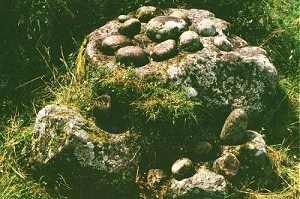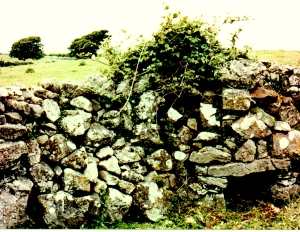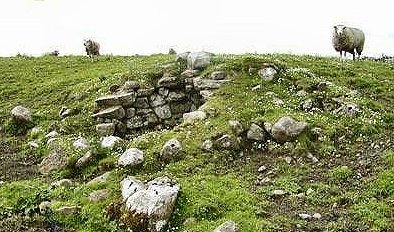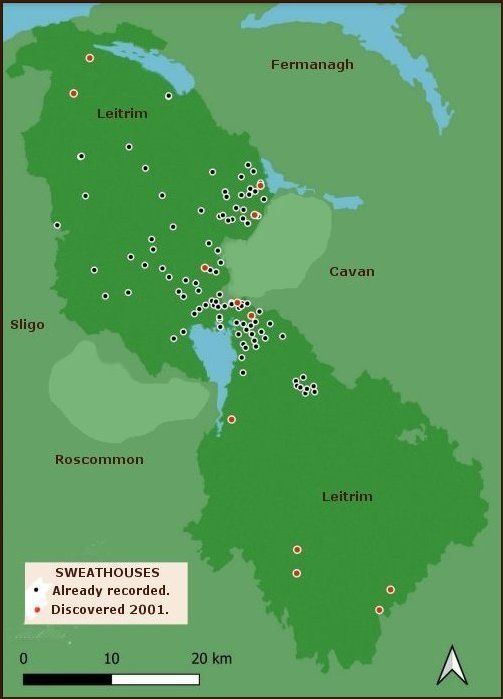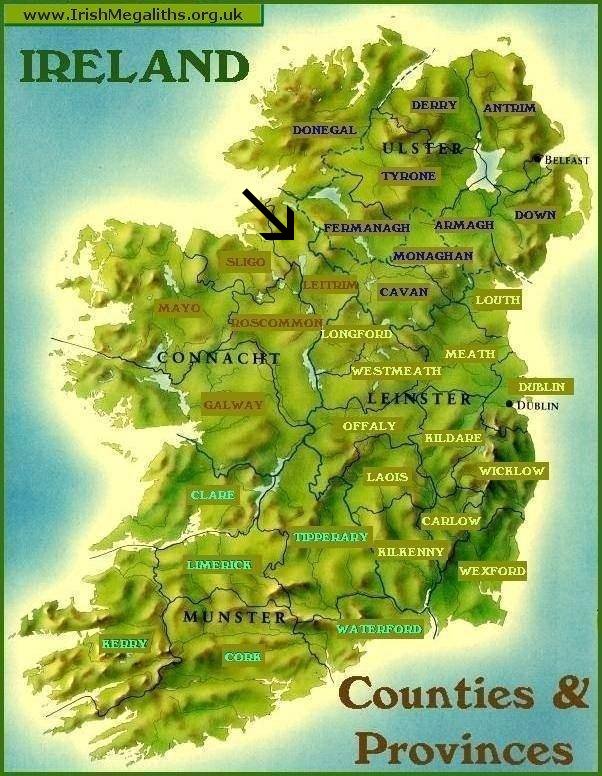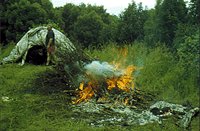|
the
earth-mother's
Recommended reading: "Sacred
and Profane Substances: the ritual use of narcotics in Later Neolithic
Europe"
FEEDBACK "My name is Tim. I
live in Washington State in the U.S.A. Outside the peyote cults (a relatively recent arrival on the Northern Plains), and occasional experimenters, there is no drug use in Lakota "sweatlodges". In fact even the Peyote Church doesn't normally use that "medicine" in an inipi (sweat-lodge) ceremony. I am very familiar with Lakota, Blackfoot, Annishnabe, Dineh, Salish, and Cheyenne culture: none of them traditionally used mind-altering drugs with the possible exception of tobacco in their ceremonies. Some individuals played around with them especially in the past 200 years, but they are not a part of traditional spirituality especially in the sweatlodge. We go into a sweat-lodge for many reasons. The one reason was alluded to in a photo caption in your article where the entrance to the lodge recalled a passage-tomb. We go in the lodge to be reborn, which of course necessitates death. As a newcomer to these ways and a person who has used drugs to expand my consciousness (with mixed results), it seems to me that drugs do not enhance the experience of an inipi ceremony. Rather they make it difficult to perceive the spirits who are called to that dark and womblike place. Psylocibes and cannibis make it difficult to tell the difference between a personal vision or hallucination, and a manifestation of the presence of a "visitor". That is the second reason we go into a sweat-lodge: to commune with the spirits of ancestors and non-human benefactors or protectors. And the third and perhaps most important reason is to pray to our creator in thanks - for a good ceremony, for good health and happiness, and for the divine to regard us as grandchildren (and whatever else we want to pray about)... I liked your article, and the last speculation about 'burnt-mounds' being sweatlodge-remains sounds about right. I'm very interested in what my ancestors may have used the sweatlodge for. I do not doubt that they used psilocybes in them. However, drugs are not necessary for interacting with other worlds and the beings in them. Experiences that we consider unusual or fantastic are not necessarily the product of drug induced hallucinations. I'd go so far as to say that the reason we consider them fantastic and unusual is a product of our delusions and the great "disremembering" you refer to. As a young man I used drugs to shake up my delusional and narrow perception of the universe. In the absence of elders and genuine spiritual traditions this was a great gift. However, now that I am in the presence of elders and good spiritual ways that are now being rekindled but never were forgotten, my former drug-use still clouds my perception of the spirit world. The farther I get from it the more able I am to see the spirits and receive their teachings..."
For information on and here >
|
|
HOW MY INTEREST IN IRISH SWEATHOUSES STARTED. My discovery of the existence of sweathouses was entirely due to Estyn Evans' Field Guide to Prehistoric and Early Christian Ireland, published in the mid-sixties. He mentioned the Rathlin one (which I never found) and the Tirkane sweathouse near Maghera, co. Derry, which I decided to visit along with the fine portal-tomb at nearby Tirnony. It was in a glen owned by a Miss Dogherty who had serious arthritis
and was getting on in years. She was thrilled that I wanted to see
her sweathouse, and she took me down the slippery slope to show
me it. After that, anytime I was in the area I called in with her.
I brought her the first peach she had ever seen, and she told me
that she had only once seen the sea (at Larne) and was still amazed
by the waves. She was a splendid woman. Later I went to see her
in hospital after a cataract operation (not the outpatient event
it is today), and later again I went to see her after a nephew (I
think) had had her house 'done up' with a grant. Gone was the turf
fire and the cosiness, replaced by a lot of formica. She didn't
like it at all. |
IRISH
SWEATHOUSES
AND THE GREAT FORGETTING
Anthony Weir
Part Two
|
In line with the Victorian insistence that explanations should be as free as possible from excitement or sin, it has generally been accepted that sweathouses were resorted to as a prophylactic sauna-treatment for aches and pains. But far more aches and pains could have been incurred in heating a sweathouse than would ever have been alleviated. For a start, the entrance is as little as 75 cms high. To light a turf fire, maintain it and sweep out the ashes, ans strew the floor with bracken or rushes was no easy task. Even if the roof were partly dismantled to put the turf in, this would have been almost as awkward as bringing or throwing it in through the entrance - and the hot ashes would still have had to be swept out. Myles
McMorrow recounted that : Each
person brought a leaf of cabbage and put it on his head to keep
the head cool and avoid headaches. An hour or so being spent in
continuous perspiration the patient clothed himself and hastily
hurried home. He then betook himself to bed having had a hot drink
of whey prior to retiring. In a society where everyone had rheumatic pains and arthritis at the very least, and where it was regarded as the normal human condition, it is it really likely that sweathouses several hundred metres from the nearest (stone) house, holding a maximum of 5 people in considerable discomfort and some risk of fainting or even burning, would have been used for the uncertain alleviation of aches and pains ?
The better-off rubbed themselves with poitín and patent rubs on sale at markets and fairs; the poorer drank what they could get - poitín, or, in mid-Ulster, ether - to ameliorate bodily discomfort. In any case, sauna treatment is of no avail to such complaints as sciatica, arthritis, and the aching backs still suffered by a high proportion of the more mature population. Arthritic hands and feet would be relieved more easily and effectively by immersion in warm peat-ash from an overnight fire than by squatting uncomfortably in a tiny, dark place. Nevertheless, there is this account on the Duchas site: There was
one on Phil Ward's land in Deffier [county Leitrim] and the walls
were there up to ten or twelve years ago. Joseph & Thomas
Mahon saw it being used. Also this: In a place
locally known as Claghan in the townland of Carrickhue [county
Derry] there lived an old woman in the middle of the last
century who was well known all over the parish for being able
to cure many ills which existed at that time. There was no surgical
operations for internal diseases such as appendicitis so all such
cases were taken to old Martha Douglas as she was called for treatment.
In the garden she had what was known as the "Sweat House"
constructed much to the design of a lime kiln. Here the patient
was placed rolled up in blankets on a large flat stone with a
fire underneath. This operation continued from twelve to twenty
four hours. Then the patient was removed and placed in a bed where
she administered medicine made from herbs. After three or four
days' treatment the patient was completely cured. Sweathouse doorway seen through a hole in
the corbelled roof, If they were not used for prophylactic purposes, why would sweathouses (never more than 1.75 metres high internally and two metres in internal diameter) be built in such numbers ? (It is safe to assume that those which survive represent a tenth or less of the total built just in the county Leitrim.) What else could they have been used for ? And when were they introduced ? A hole in the corbelled roof photographed
from inside the sweathouse at Annacarney in county Wicklow, Mrs McLoughlin of Tullynafreave (Leitrrim) claimed in 1992 that her maternal great-grandfather built the sweathouse standing some 50 metres from her modern dwelling to save his wife the trouble of travelling to the sweathouse in neighbouring Meenaslieve. She said that her grandmother and perhaps her mother also had used it, and did not think that their spouses had done so. But whether this is an isolated example of late construction (say around 1885) is impossible to determine. Similarly, it is impossible to establish a connection with the coal-mines (in use from the late eighteenth to the late twentieth centuries) that are at the heart of the present distribution of sweathouses - now reported also from south-west Scotland. Sweathouses are, of course, part of a circumpolar phenomenon which produced the now well-known Finnish sauna. The Turkic tribes who moved from central Siberia and eventually overthrew the Byzantine Empire, seem to have easily adapted to the Byzantine and Roman steam-bath, producing the hammam or Turkish Bath. The North American form was the sweat lodge, used not for mere hygienic reasons, but for spiritual and physical purification, and sometimes as part of the initiation procedures for boys' passage into manhood. We can be sure that the Finnish sauna was not used for merely hygienic reasons before the 19th century obsession with cleanliness as the prime virtue took hold in the Protestant countries of the North.
The first Turkish Bath to be established in the British Isles was in county Cork in the 1860s - so there is no likelihood that it inspired simple Irish sweathouses, concentrated much farther north. The Finnish sauna was an offshoot from a Siberian-Mongolian practice, so it is reasonable to suppose that the Irish sweathouse came from Scandinavia via the Vikings or their Gallowglass successors in the Northern Isles at some time between the 10th and the 15th centuries. That they are not found near the Viking settlements can be explained by the subsequent Norman and English occupation and expansion of those areas. Before their secularisation, saunas were part of the universal combination of religious, medicinal and psycho-therapeutic modes which have only recently, like much else, been split off and compartmentalised by Western science and pseudo-science. Our culture has, as a consequence, taken 'exotic' and exciting elements of other cultures' psycho-social therapies (coffee, cocoa, tobacco, cocaine, cannabis and so on) as mere stimulants and 'highs'. The Turks made the public hammam a part of quasi-religious male confraternity. The Finns have likewise made the communal sauna a kind of men's club. Sweating is one of the many ways of altering consciousness, particularly when it is part (as sometimes in North America) of a series of tests and ordeals - and especially when it is done in the dark. But there is no evidence that the small Irish sweathouses were used in the distinctly religious and reverential way that the large North American sweat-lodges were used - and such a highly-evolved function is most unlikely. Something that few people allow themselves to realise is that many Native Americans were much more emotionally mature than the European invaders, who had (and have) destructive technologies way beyond their wisdom or insight or sensibility. The medicinal psycho-therapy of Siberia and Mongolia, which is still practised by shamans both male and female, involves mushrooms (Fly Agaric), alcohol, sweating and rapid cooling, fasting, whirling, sleep-deprivation and so on. These produce visions and out-of-body experiences, and are aids to achieving more aware states of consciousness than 'Western values' approve of, whereby the shaman-practitioner can see causes of illness or malaise, and the non-shaman can be suitably awed by the psychic forces released by the unblocking effects of physical ordeal and psychoactive drugs. Herodotus describes the Scythian practice of altering consciousness through cannabis by throwing the seeds on hot stones inside a tent and inhaling the vapour - the smoking of cannabis and opium is a rather late development. Long before the Scythian incursions, however, cannabis seems to have been inhaled at La Hougue-Bie on the island of Jersey, where 21 pottery vessels marked with burnt resin were found in the untouched chamber recently discovered. Consciousness-improving substances have, of course, been found also in other European sites: the Iron Age site of Wilmersdorf, for example, where remains of cannabis were found in an urn. Sweathouse with unusually large and grand
entrance Closer to Ireland there have been serious suggestions that the "burnt mounds" also known as "ancient cooking-places" or fulachta fíadh, found in huge numbers in Ireland - and also in Britain - might have been used as sweat-lodges in the North American style, or as places for warm-water bathing. These shallow ponds, heated by rolling hot stones into them, could have had many purposes, of course - and warm baths would have been an obvious secondary function. Could Irish sweathouses be a continuation of a tradition as old as the fulachta fíadh ? They are very flimsy structures, easily subject to total demolition by livestock, and would survive from prehistoric times only through the most extraordinary circumstances - so no evidence is likely to emerge. None has ever been excavated. Their general disuse seems to have started after Catholic Emancipation in 1829. After the horror of the Famine, the Catholic church set about removing all 'pagan' and 'immoral' practices on the island, and instituted a very unpleasant kind of Catholic Calvinism (reinforced by the reactionary pietist policies of Pius IX) of which everyone is now aware, and which is described in several Irish novels, notably Old God's Time by Sebastian Barry. Patrick Shields wrote to historian Seaton F. Milligan in 1890 that as many as six or eight men stripped off and went in, then all openings were closed except what afforded a little ventilation. When they could suffer the heat no longer they came out and plunged into a pool of water within a yard or two of the sweat house. Naked, illiterate labouring men packed close together in a primitive, sensual practice would certainly not have been approved of by Ireland's new bourgeoisie of interfering and sexually-repressed clergy. On the other hand, Seán Ó Céilleachair, a teacher in a Co. Leitrim National School some decades later asked his pupils to ask their parents about sweathouses. Here is part of one hearsay account, from the duchas website, where many such reports have been scanned and posted.
I
have never seen a stone seat built into a sweathouse, though I
have seen candle-niches. The remoteness of the ones now found may reflect a purge of them by clerics and 'pious' types, and a desire to keep them out of sight of the new oppressors.. Greesah is, interestingly, Scots-Irish for embers.
Smoke-hole eand closing-stone on top of the
sweathouse at Lurgaboy, co. Roscommon.
Cornaguilla, county Leitrim.
However, there is absolutely no evidence of the ingestion of Psilocybe in Ireland. Corradeverrid, county Cavan, reportedly built by a Dr Greden If Irish sweathouses were used like the secularised hammam and sauna, why were they not built close to stone-built dwellings and their turf-stacks ? Why were they, as reported, used infrequently - mostly in the Autumn ? Were they used exclusively by one sex ? Does one report of an "itinerant bath-master" indicate a psycho-therapeutic use supervised by a travelling doctor-shaman or Wise Man ? And why, in a country which, until the use of chemical fertlisers, was in October and November (the time of The Gap of the Year, Samhain, Hallowe'en) carpeted with Psilocybe semilanceata, also known as Liberty Caps, is there no record of their use ? These mushrooms are still plentiful on marginal land and on the edges of chemically 'fertilised' agricultural land. But there is a pattern of "collective forgetting" of mind-expanding plants and their extracts by cultures which inevitably adopt manufactured mind-numbing drugs such as alcohol. Thus the identity of Soma was lost, and only inactive "substitutes" were identified. It is possible) that Psilocybe mushrooms - probably as an infusion, maybe with other herbs - were consumed up to the time of the Famine - but of course the agonising and protracted trauma of the hungry years and the halving of the population by death and emigration affected Irish behaviour and negative or hostile attitudes to Wild Food or "famine food" - such as nutritious nettles, rose-hips, elderberries, weall-pennywort, and so on. After the Famine, only grocery-store victuals were eaten. Even now, eating blackberries is far from universal in Ireland: those who pick them tend to be English, other foreigners, or local children paid (a penny a pound, as I remember in the 1960s) to gather them. Tullynahaia, county Leitrim For the decline of Irish traditions right across the spectrum, the Famine was Pelion piled upon the Ossa of Catholic Emancipation of 1829. This resulted in the rapid application to Ireland of a very urban-English Victorian-puritan 'respectability' that ran counter to many of the old ways and practices which had survived until the Penal days - practices which were bowdlerised and Christianised when they could not be suppressed. Ireland became for the first time - and remained until the end of the 20th century - a highly-conservative society which had also lost its traditions, and whose mores came from the right wing of the Catholic church. This is in contrast to Italy, for example, where all sorts of "pagan" survivals (from frog-cults and wolf-veneration to bleeding statues) can still be found in the centre and south, while sceptical atheism is almost the norm in Tuscany and the north. Annagh Upper (side view), county Leitrim. So, after the Famine, few would have claimed or admitted to remember the eating of Psilocybe, which, it should be noted, were free, abundant and (through drying) available all year, and produce a state of consciousness far above that induced by alcohol – which requires a compicated process to produce, and money to otherwise obtain. The world-wide phenomenon of the replacement of natural, easily-ingested and fairly benign plants by manufactured, expensive and toxic alcohol is a sad paradigm for the take-over of the world by toxic "turbo-capitalism". In the same way, 'pagan' practices such as painting or capping phallic stones, using cure-stones (which were promptly and cleverly dubbed curse-stones) some of which still survive, wild dancing (for which the Irish were famous) and the veneration of Fairy Thorns were discouraged. Cure-stones, Killinagh, county Cavan But Psilocybe mushrooms would surely have been recognised and taken (probably as a tea, or even as they were collected) in Ireland (and elsewhere), since they were so plentiful (right up until recent poisoning of so much agricultural land) - yet we have (so far as I know) no record, no evidence. Humans never miss out on a source of intoxication or hallucination (from ayahuasca to glue), no matter how complicated the process of extracting it. Moreover, traditional societies 'knew their mushrooms' even better than they do today (everywhere except the British Isles). Did whiskey (first recorded in the 12th century) gradually supplant mushrooms ? I If dark, chthonic sweathouses had a psycho-therapeutic function stretching back at least to Bronze Age times, we can be sure that they too would have been discouraged by the twin powers of Church and State. By the time that uncasual enquiries started (after the First World War) they had fallen into desuetude, and their use had been erased (like much else) from the collective memory. If they had been widespread across the island, they were destroyed by agricultural encroachment in the fertile lowlands, surviving only in the remotest districts or by sheer accident. The Church abhorred mystical or psychedelic experiences that it saw as demonic and could not control. It was much happier with alcohol, the consumption of which was regulated in the first instance by Her Majesty's Customs and Revenue men, except in remote and 'backward' parts. Small wonder that enquirers were fobbed off with glib explanations of autumnal prophylaxy and 'sweating out the bad' as Mrs McLoughlin of Tullynafreave expressed it. But sweating out the bad might very well have been more than a figure of speech in a desperately poor region in a poor country where every new mouth to fill was a curse, and one too many could reduce a family to destitution and starvation. Mrs McLoughlin stated that only the women in her family had used the sweathouse. If only women used them, it is very possible that they were part of a procedure to induce miscarriage in unwanted pregnancies. Hot baths are a classic part of this procedure, and more effective if followed by cold ones. Ingestion of a large dose of Psilocybe mushrooms is also abortifacient. The water which is near so many sweathouses could also have been most useful for cleansing after a successful miscarriage. And finally, the distance and in some cases difficulty of access would ensure privacy and itself aid the process. The 'Itinerant Bathmaster' could well have been a Wise Man practised in the art of inducing miscarriages. Perhaps he was also a sweathouse-builder – for it would take some skill in building dry-stone walls to construct a sweathouse. Sweating and dunking in cold water could have been a purifying prelude to the consumption of mushrooms, perhaps at home. I have gone through the reverse procedure (in the 1980s) during which I felt physically intimate with 'Nature', sitting on the ground and feeling roots growing out from my anus. They could not have been social like Finnish saunas or Struell Wells in county Down. Nor were they 'sacred spaces'. As to their origin, a distant Viking connection is quite possible, because artefacts and traditions can hang on for hundreds of years in remote areas. Maybe Sligo in the NW, close to county Leitrim, was the chief point of entry. Saunas are and presumably always were made of wood, hence quickly rotted and forgotten, but in stony and boggy areas an adaptation could well have occurred and survived. There are descriptions in the National Folklore Collection about sweathouses with clay walls and thatch rooves. It is worth noting that the isolated group in county Louth is not far from Carlingford, a Norse settlement with a Norse name. By the dawn of the 20th century very few - if any - people knew how sweathouses had been used, for in Ireland the rupture of handed-down knowledge, especially from mothers to daughters, occurred earlier than almost anywhere else in rural Europe. The Great Famine resulted, as I have said, in a collective Irish shame associated with traditional practices, the native language, and "wild food". It is curious that no accounts of them suggest an 'otherworldly' connection; no mention of the sídhe or 'good folk' as there has been been with reference to mounds or cairns and other ancient structures. This would tend to contradict the mushroom-imbibing theory. How much arcane knowledge died in the hedges with Famine victims, or was carried across the ocean to America and deliberately forgotten there, we will never know. What we can be sure of is that there has been in Ireland a Great Disremembering (encouraged by the Church) which acted as undertaker to the Great Hunger, and may still not have run its course. And although sweathouses still lurk in secret places and leprechaun-hatted Psilocybes still grow, their use and possible connection remain as obscure to us as the mind-set of Mesolithic hunter-gathers, the cosmology of Celtic kinglets, or the ecstasy of Atlantic anchorites.
_________________________________________________________
[This text has been expanded from articles
which previously appeared in
For
valuable accounts of sweathouses and people who used them,
View slide-show >
Sweathouses in county Leitrim (after Leitrim
Sweathouse Project Report, 2001).
In a quasi-erudite essay on 'Irish Soma', Peter Lamborn Wilson (aka Hakim Bey) asked if Psilocybe and Fly Agaric (Amanita muscaria) grew in Ireland in ancient times. Of course they did - in huge numbers. I am interested in this question because I take microdoses (1 gram) of Psilocybe twice a week to alleviate mild bipolarity, and they work marvellously well. Can Psilocybe semilanceata have escaped the attention of people in Europe (and on the Mainland to this day) who could distinguish between wholesome, tasty mushrooms such as the once-ubiquitous Agaricus campestris and similar-looking poisonous ones) and who knew very well the effects (both salutary and dangerous) of Fly Agaric ? Sweathouses were apparently used mainly in autumn, when Psilocybe semilanceata was plentiful. Could it have been a secret part of the treatment – for example, the 'herbs' administered by the Old Woman mentioned above ? For a couple of years I took microdoses of Psilocybe 'truffles' to alleviate depression, and they worked well - until they didn't. The sameness of reports on sweathouses is suspiciously similar to the uniformity of other rural pseudo-myths, such as dock-leaves relieving nettle-stings, bats nesting in hair, or the definition of prehistoric tombs as Giant's Graves. APPENDIX II from
the Birmingham (Warwickshire) City Council's website:
|
![]()
DOWNLOAD THESE TWO PAGES AS A PDF FILE
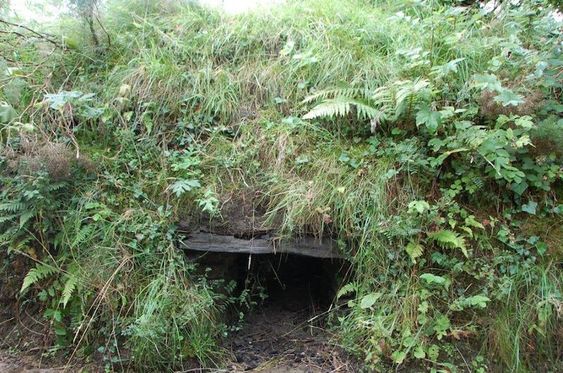
Sweathouse near Keadue, county Roscommon.
|
SELECT
BIBLIOGRAPHY
Cagney, Lydia 2003. Report on the archaeological excavation of Fulacht Fiadh at Ballinaspig More 6, Ballincollig, Co Cork. Archaeological Consultancy Services Ltd. Danaher, Kevin, Lucas, A.T. 1952. Sweathouse, Co. Tyrone. Journal of the Royal Society of Antiquaries of Ireland 82 (2), 179–180. Dowd, Marion 2018. Bewitched by an Elf Dart: Fairy Archaeology, Folk Magic and Traditional Medicine in Ireland. Cambridge Archaeological Journal 28 (3), 451–473 https://www.cambridge.org/core/journals/cambridge-archaeological-journal/article/bewitched-by-an-elf-dart-fairy-archaeology-folk-magic-and-traditional-medicine-in-ireland/7EF2D9BD63A34CAA405A42E120C4D421 Edelsward, Lisa-Marlene 1991. Sauna as Symbol: Society and Culture in Finland. American University Studies, Series XI: Anthropology and Sociology vol. 53. Peter Lang, New York. Fairbrother, Andrew 2019. Irish Sweat-Houses: An Experimental Archaeological Investigation and Study. School of Archaeology. University College Dublin. (Unpublished Masters dissertation.) García-Quintela, Marco V., Santos Estévez, Manuel 2015. Iron Age Saunas of Northern Portugal: State of the Art and Research Perspectives. Oxford Journal of Archaeology 34 (1), 67–95. Harte, Aidan 2010. The Munster Sweathouses Project. North Munster Antiquarian Journal 50: 77–88. Harte, Aidan 2012. An Teach Allais – an archaeological examination of the Irish Sweathouses of Munster, South Leinster and West Connaught. Munster Archaeology 5. Harte, Aidan 2021. Leitrim Sweathouse Project Report 2021 Hernández-Ávila, Inés 1996. Mediations of the Spirit: Native American Religious Traditions and the Ethics of Representation. American Indian Quarterly 20 (3/4), 329–352. Inchon, Alain 1977. A Late Postclassic Sweathouse in the Highlands of Guatemala. American Antiquity. 42 (2), 203–209. Keaney, Harry 2010. Vikings had a much bigger presence in Sligo than had been first thought. The Irish Independent. https://www.independent.ie/regionals/sligochampion/lifestyle/vikings-had-a-much-bigger-presence-in-sligo-than-had-been-firstthought-27568729.html. Kearns, Katie 2016. Understanding sweathouses in Ireland with special reference to County Leitrim. University College Dublin. (Unpublished Masters dissertation.) Kearns, Katie 2021. The Sweathouses of Ireland : The disappeared folk-tradition of sweat bathing. Latimer, W.T. 1894. Sweat-House, near Eglish, County Tyrone. Journal of the Royal Society of Antiquaries of Ireland 4 (2), 180. Lockwood, F.W. 1901. Some Notes on the Old Irish “Sweat-Houses” at Assaroe, Ballyshannon; And Kinlough, Co. Leitrim, and on Several Rude Stone Monuments near Bundoran and Ballyshannon. Ulster Journal of Archaeology 7 (2), 82–84. Logan, Patrick 1972. Making the cure: a look at Irish folk medicine. Talbot press, Dublin. May, A. McL 1938. Sweat Houses (Toigthe Alluis) of County Londonderry. Ulster Journal of Archaeology 1938 (1), 44–45. McCormick, Finbar 2017. Struell: bathing at midsummer and the origins of holy wells. BisWorch C. – Theune C. (eds.) Religion, Cults & Rituals in the Medieval Rural Environment. Ruralia XI. Sidestone Press, Leiden, 69–77. Mc Hugh, B. 2002. Sweathouses – The Irish Sauna. Killavoggy. Leitrim: Carrick Print, 21. Miller, Catherine. A. 2013. Earth. Water. Sky – The Liminal Landscape of the Maya Sweatbath. Doctoral dissertation. Virginia Polytechnic Institute and State University. Milligan, Seaton. F. 1889. The Ancient Irish Hot Air Bath. Journal of the Royal Historical and Archaeological Association of Ireland 9 (81), 268– 270. Moriarty, Colm 2012. The enigmatic fulacht fiadh or burnt mound. Irish Archaeology. http://irisharchaeology.ie/2012/07/the-enigmatic-fulacht-fiadhburnt-mound/. Mulcahy, D.B. 1891. An Ancient Irish Hot-Air Bath, or Sweat-House, on the Island of Rathlin. Journal of the Royal Society of Antiquaries of Ireland 1 (7), 589–590. National Monuments Service (NMS). Sites and Monuments Record (SMR). 2011. Anaverna, Co. Louth. SMR no.: LH004-123---. Compiled by: Claire Breen. NMS. SMR. 2009. Ballyourane, Co. Cork. SMR no.: CO132-009002-. NMS. SMR. Carrowmaloughlin, Co. Mayo. SMR no.: MA087-064----. NMS. SMR. 2010. Crosshill, Co. Roscommon. SMR no.: RO002-024----. Compiled by: Michael Moore. O’Donovan, Patrick F. 1995. Archaeological Inventory of County Cavan. Stationery Office, Dublin, 239–243. Ó Giolláin, Diarmuid 2000. Locating Irish Folklore: Tradition, Modernity, Identity. Cork University Press, Cork. Richardson, P. 1939. Sweathouses between Blacklion and Dowra, County Cavan. Ulster Journal of Archaeology 1939 (2), 32–35. Sando, Linnea C. 2014. The Enduring Finnish Sauna in Hamlin County, South Dakota. Material Culture, 46 (2), 1–20. Singh, Manvir 2025. Shamanism: The Timeless Religion, Allen Lane, London. Wakeman, W.F. 1890. The Hot-air Bath. The Proceedings and Papers of the Royal Society of Antiquaries of Ireland. Fifth series. 2 (1), 165. Weir, Anthony 1979. Sweathouses and simple stone structures in County Louth and elsewhere in Ireland. County Louth Archaeological and Historical Journal. 19 (3), 185–196. Weir, Anthony 1989.
Sweathouses: puzzling and disappearing. Archaeology Ireland,
3 (1), 11–13. Williams, Brian 2014. Cornacully, Fermanagh. http://www.excavations.ie/report/1988/Fermanagh/0000791/.
Some Online Archive Sources
Ballymahon. Co. Longford. https://www.duchas.ie/en/cbes/5009142/4990873. Brideswell, Co. Roscommon. https://www.duchas.ie/en/cbes/4811596/4800327. Buckode, Co. Leitrim. https://www.duchas.ie/en/cbes/4602728/4599005. Carrickmore, Co. Armagh. https://www.jstor.org/stable/48568195 Carrowmenagh, Co. Donegal. https://www.duchas.ie/en/cbes/4493786/4420259. Cartronavally, Co. Roscommon. https:// www.duchas.ie/en/cbes/4758451/4745077. Clones, Co. Monaghan. https://www.duchas.ie/en/cbes/4723856/4719443. Cloontamore, Co. Longford. https://www.duchas.ie/en/cbes/5009152/4992177. Cloonty, Co. Leitrim. https://www.duchas. ie/en/cbes/4602726/4598692. Corellstown, Co. Westmeath. https://www.duchas.ie/en/cbes/5009057/4981914. Cornageeha, Co. Leitrim. https://www.duchas.ie/en/cbes/4605944/4604551. Cornamucklagh North, Co. Leitrim. https://www.duchas. ie/en/cbes/4605945/4604677. Corratawy, Co. Cavan. . https://www.duchas.ie/en/cbes/5044788 /5038152/5081569. Doon. Co. Limerick. https://www. duchas.ie/en/cbes/4922081/4850597. Drumkeeran, Co. Leitrim. https://www.duchas.ie/en/cbes/4605932/4603675. Drumshanbo, Co. Leitrim. https://www.duchas.ie/en/cbes/4605949/4605190. Drumaweir, Co. Donegal. https://www.duchas.ie/en/cbes/4758450/4745008. Greaghnafarna, Co. Roscommon. https://www.duchas.ie/en/cbes/4758450/4745008. Killoscully, Co. Tipperary. https://www.duchas.ie/en/cbes/4922154/4856704/5012408. Manorhamilton, Co. Leitrim. . https://www.duchas.ie/en/cbes/4602749/4600924. Mullaun, Co. Leitrim. https://www.duchas.ie/en/cbes/4602754/4601327. Shancurry, Co. Leitrim. https://www.duchas.ie/en/cbes/4605955/4605654. Toor, Co. Tipperary. https://www. duchas.ie/en/cbes/4922161/4857271. Urball, Co. Leitrim. https://www.duchas.ie/en/cbes/4605947/4604866/4652069. Valleymount, Co. Wicklow.https://www.duchas.ie/en/cbes/5044723/5034522. plus : https://www.jstor.org/stable/27729480 (My original article from 1979 on co. Louth sweathouses.) THE_SWEATHOUSES_OF_IRELAND_THE_DISAPPEARED_FOLK_TRADITION_OF_SWEAT_BATHING
see also the Leitrim Sweathouse Project Report 2021 which
contains photos and a full discussion. |
Recently I found this picture of a sweathouse in county Leitrim in
an article in Malayalam
on a Kerala (South India) newspaper website.

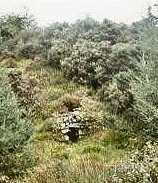
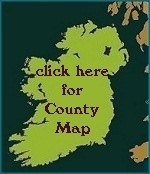

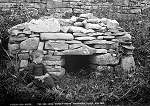
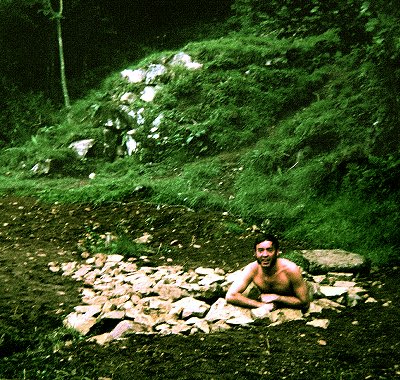

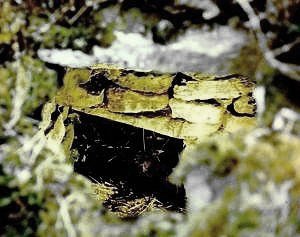
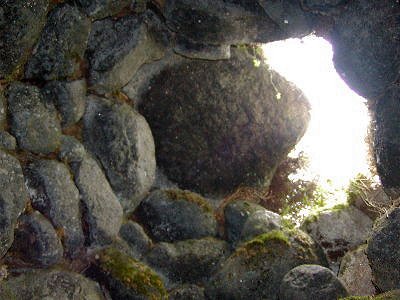
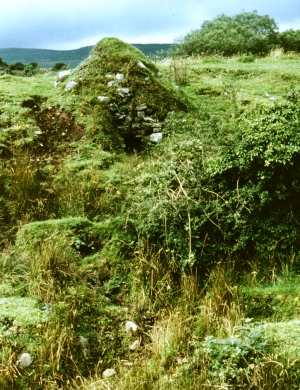
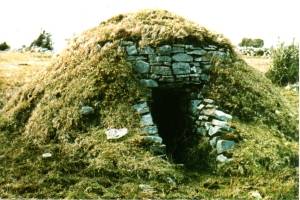
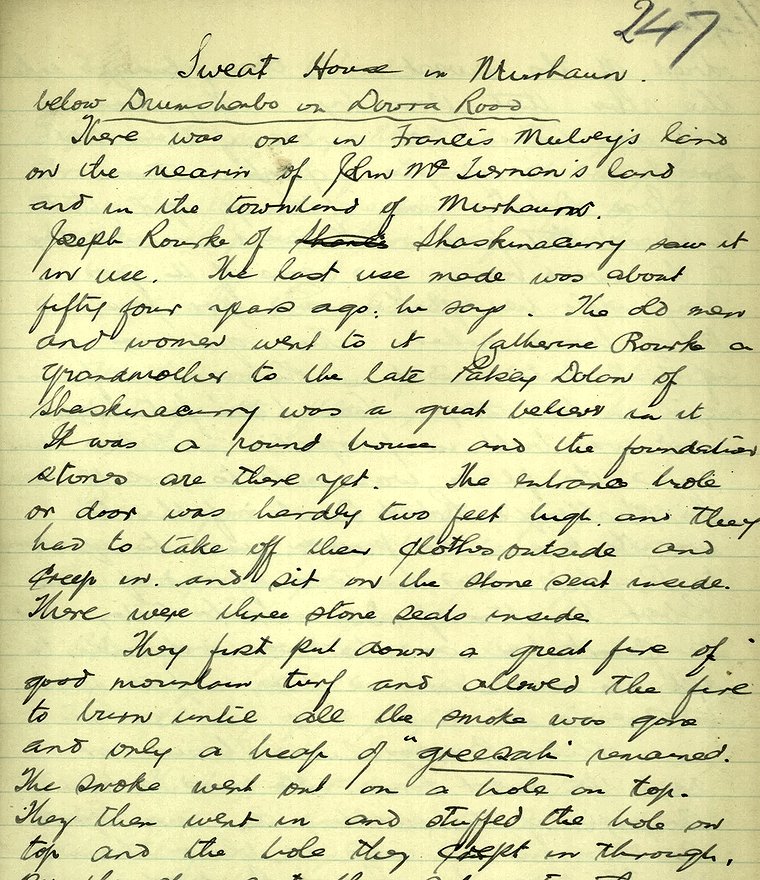
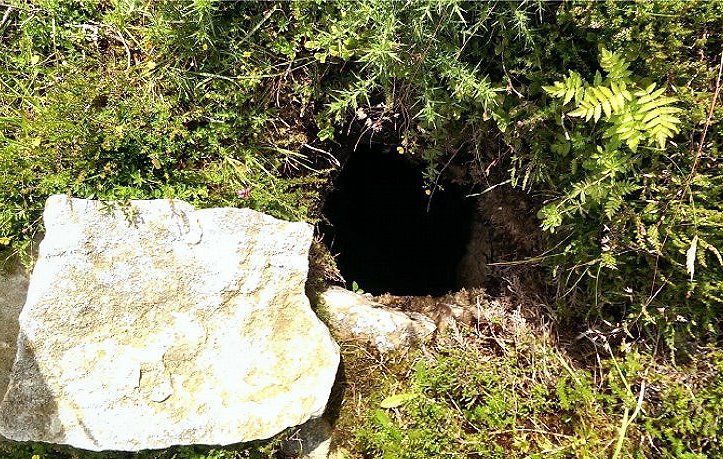
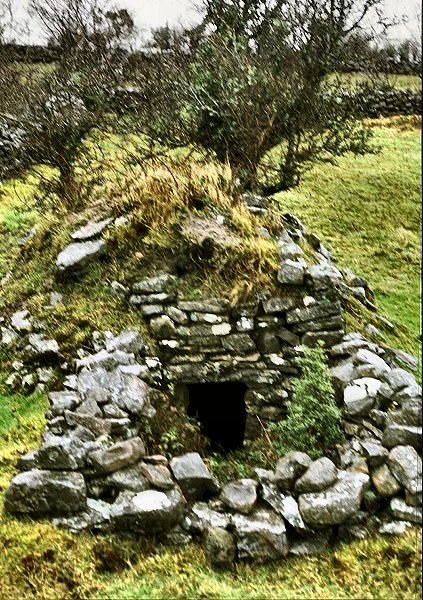

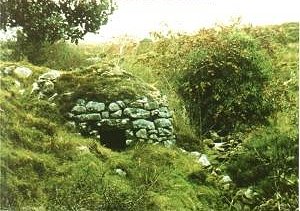
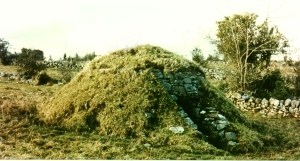 larger photo
larger photo